Term 3 Unit 4 | History | 6th Social Science - South Indian Kingdoms | 6th Social Science : History : Term 3 Unit 4 : South Indian Kingdoms
Chapter: 6th Social Science : History : Term 3 Unit 4 : South Indian Kingdoms
South Indian Kingdoms
Unit 4
South
Indian Kingdoms
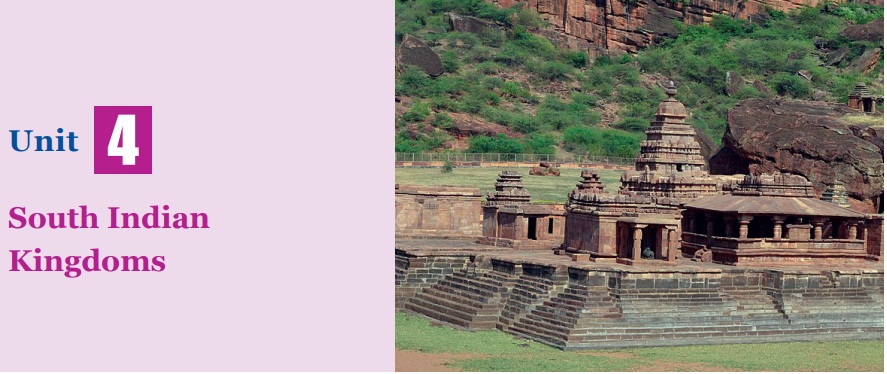
Learning Objectives
• To know the southern Indian states that emerged after the fall
of the Mauryan Empire
• To acquire
information of the
ruling dynasties such
as Pallavas, Chalukyas and Rashtrakutas and their domains
• To understand
their contribution to society and culture with reference to literature, art and
architecture
• To become
familiar with the artistic and architectural splendour of Mamallapuram shore
temple, Ellora monuments and Elephanta cave temples
South
Indian Kingdoms
By the early 7th
century, synchronising with the Harsha’s reign in the north, the far south had
come under the control of the Pallava kings of Kanchipuram. Pallava sovereignty
included the domains of the Cholas and the Pandyas. The latter were then
emerging as ruling dynasties in their respective river valley regions. Much of
the central and eastern Deccan was under the Chalukyas of Badami (Vatapi), who
were then pushed away by the Rashtrakutas. The medieval period in India was
marked by thee mergence of regional centres of power. There was no single
imperial power like Mauryas or Guptas who exercised control over the greater part of India in this
period.
The
Pallavas
The Pallava kings
ruled around the prosperous agrarian settlement and important trade centre of
Kanchipuram on the southeast coast of India. Kanchipuram was well known to
Chinese and Roman merchants. From the flourishing trade centre of Kanchipuram,
the later Pallavas extended their sovereignty over all the Tamil-speaking
regions during the 7th and 8th centuries. The central part of their kingdom,
however, was Thondaimandalam, a large political region comprising northern
parts of Tamil Nadu and the adjoining Andhra districts.
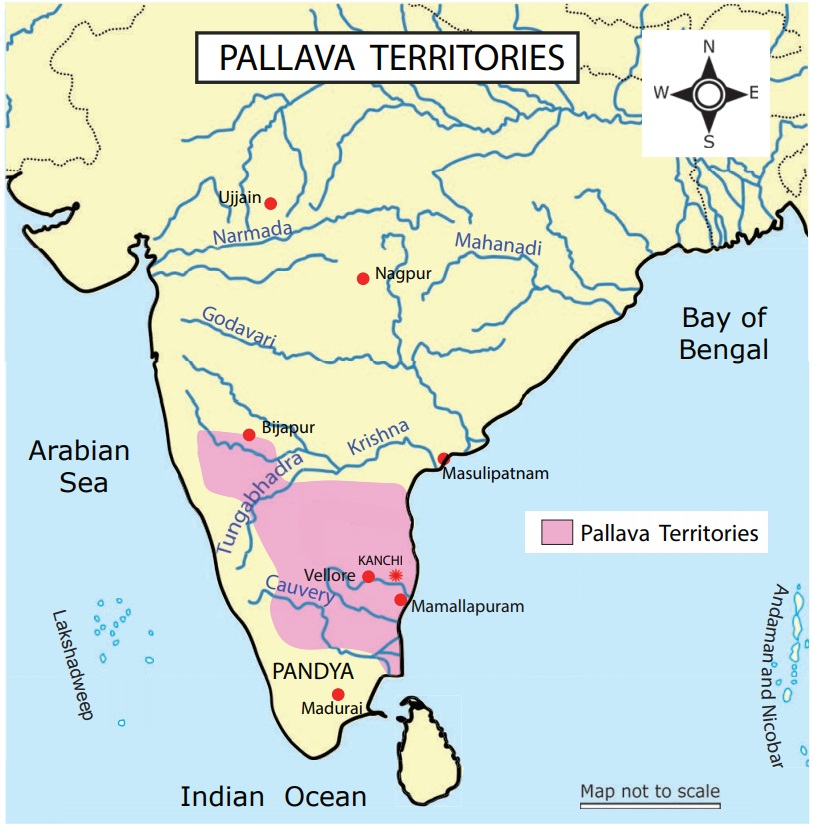
Sources
Inscriptions Mandagapattu Cave,
Aihole Inscription of Pulakesin II
Copper Plates Kasakudi Plates
Literature Mattavilasa Prahasana, Avanthi
Sundarakatha, Kalingathu Parani,Periya Puranam, Nandi Kalambagam
Foreign Notice Accounts of Chinese
traveller Hiuen Tsang
Pallava Genealogy (Prominent
Kings)
There were early
Pallava rulers who were feudatories of Satavahanas. Simhavishnu, son of Simhavarman
II (around550AD(CE),created a strong Pallava kingdom after destroying the
Kalabhras. He defeated many kings in the south including the Cholas and the
Pandyas. His able son was Mahendravarman I. He was succeeded by his son
Narasimhavarman I. The other prominent Pallava rulers were Narasimhavarman II
or Rajasimha and Nandivarman II. The last Pallava ruler was Aparajita.
Mahendravarman (c.600–630AD
(CE)) contributed to the greatness of the Pallava kingdom. Mahendravarman I was
a follower of Jainism in the early part of his rule. He was converted to
Saivism by the Saivite saint Appar (Tirunavukkarasar). He was a great patron of
art and architecture. He is known for introducing a new style to Dravidian
architecture, which is referred to as ‘Mahendra style’. Mahendravarman also
wrote plays, including (c.620) MattavilasaPrahasana. (The
Delight of the Drunkards) in Sanskrit, which denigrates Buddhism.
Mahendravarman’s
reign involved constant battles with the Western Chalukya kingdom of Badami
under Pulakesin II. Pulakesin seems to have defeated Mahendravarman in one of
the battles and taken over a large part of his territory (Vengi) in the north.
His son Narasimavarma I (c. 630–668) avenged the defeat by capturing Vatapi,
the capital of Chalukyas. He set Vatapi on fire, killing Pulakesin in the
process.
Narasimhavarman I’s army general was
Paranjothi. Popularly known as Siruthondar (one of the 63 Nayanmars),
Paranjothi led the Pallava army during the invasion of Vatapi. After the
victory he had a change of heart and devoted himself to Lord Siva –PeriyaPuranam
Narasimhavarman II
(c. 695–722), also known as Rajasimha, was a great military strategist. He
exchanged ambassadors with China. His reign was comparatively free from any
political disturbance. Therefore, he could concentrate on temple-building
activities. During his reign, the famous Kailasanatha temple at Kanchipuram was
built.
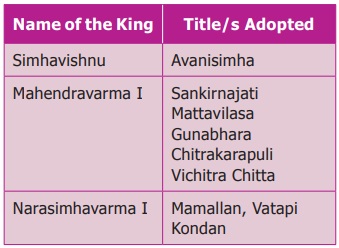
Pallava’s
Contribution to Architecture
Pallava period is
known for architectural splendour. The Shore Temple and various other temples
carved from granite monoliths and the Varaha cave (7th century) at
Mamallapuram, are illustrious examples of Pallava architecture. In 1984,
Mamallapuram was added to the list of UNESCO World Heritage Sites.
Pallava
architecture can be classified as
1. Rock-Cut
temples – Mahendravarman style
2. Monolithic
Rathas and Sculptural Mandapas – Mamallan style
3. Structural
Temples – Rajasimhan style and Nandivarman style
Mahendra
Style
The best example of
MahendraVarma style monuments are cave temples at Mandagapattu, Mahendravadi,
Mamandur, Dalavanur, Tiruchirapalli, Vallam, Tirukazhukkundram and
Siyamangalam.
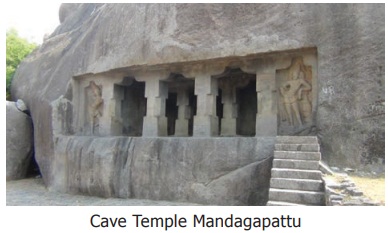
Mamalla Style
The five rathas
(chariots), popularly called Panchapandavar rathas, signify five different
style of temple architecture. Each ratha has been carved out of a single rock.
So they are called monolithic. The popular mandapams (pillared pavilions) they
built are Mahishasuramardhini mandapam, Thirumoorthi mandapam and Varaha
mandapam.
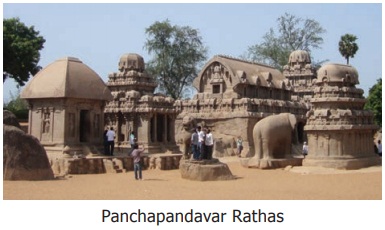
The most important
among the Mamalla style of architecture is the open art gallery. Several
miniature sculptures such as the figure of lice-picking monkey, elephants of
huge size and the figure of the ascetic cat have been sculpted beautifully on
the wall of a huge rock. The fall of the River Ganga from the head of Lord Siva
and the Arjuna’s penance are notable among them. The Great Penance panel is
considered to be the world’s largest open-air bas relief.
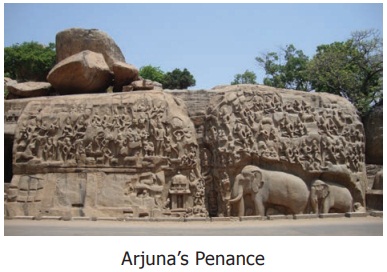
Rajasimha
Style
Narasimhavarma II, also known as Rajasimha,
constructed structural temples using stone blocks.The best example for the
structural temple is Kailasanatha temple at Kanchipuram. This temple was built
by using sand stones. Kailasanatha temple is called Rajasimheswaram.
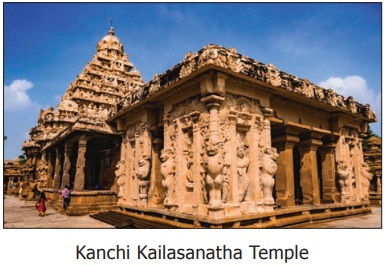
Nandivarma
Style
The last stage of
the Pallava architecture is also represented by structural temples built by the
later Pallavas. The best example is Vaikunda Perumal temple at Kanchipuram.
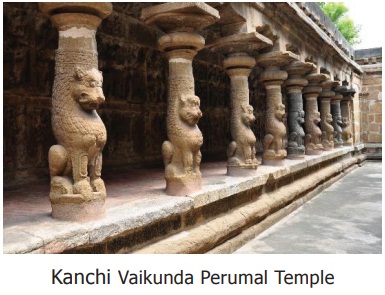
Society and
Culture
The Pallavas
supported Jainism, Buddhism and the Vedic faith. They were great patrons of
music, painting and literature. Some of the Pallava kings patronised the
Azhwars and Nayanmars. These exponents of Bhakti Cult preached a new form of
Vaishnavism and Saivism. Among the Saivites were Appar and Manikkavasakar.
Among the Vaishnavites were Nammazhvar and Andal. The Bhakti movement aimed at
preaching a popular faith, in which prayers in Tamil were preferred to those in
Sanskrit. Women were encouraged to participate in the religious congregations.
The Tamil devotional cult was competitive with Buddhism and Jainism. Therefore
the latter suffered a gradual decline in most parts of Tamil country.
Education
and Literature
* Gatika (monastery or centre of learning) at
Kanchi was popular during the Pallava times and it attracted students from all parts of
India and abroad.Vatsyaya who wrote Nyaya Bhashya was a teacher at Kanchi
(Gatika) .
* The treatise on Dakshin Chitram (Paintings of
South India) was compiled during the reign of Mahendravarma I.
* The great Sanskrit scholar, Dandin, lived in the
court of Narasimhavarma I. Dandin composed Dashakumara Charita.
* Bharavi, the great Sanskrit scholar, lived in
the time of Simhavishnu. Bharavi wrote Kiratarjuniya, an epic in verses.
* Tamil literature had also flourished during the
Pallava rule. Thevaram composed by Nayanmars and Nalayradivyaprabantham
composed by Azhwars, which are still chanted by devout people. Perundevanar,
who was patronized by Nandivarman II, translated the Mahabharata into Tamil as
Bharathavenba.
Pallava Art
The Pallava kings had
also patronised fine arts. The music inscriptions in Kudumianmalai and
Thirumayam temples show Pallavas’ interest in music. The famous musician
Rudracharya lived during Mahendravarma I. The sculptures of this period depict
many images in dancing postures.
The Chalukyas
The Chalukyas ruled larger parts of west and
centre of South India, consisting of Maratha country with Vatapi (Badami) as their capital. There were three distinct but
closely related and independent Chalukya dynasties. They were (1) Chalukyas of
Badami, (2) Chalukyas of Vengi (Eastern Chalukyas) and (3) Chalukyas of Kalyani
(Western Chalukyas). These Chalukyas held Harsha in the north, the Pallavas in
the south and Kalinga (Odisha) in the east.
Sources
Inscriptions
Badami Cave Inscription of Mangalesha
Kanchi Kailasanatha
Temple Inscription
Pattadakal Virupaksha
Temple Inscription
Aihole Inscription of
Pulakesin I
Foreign
Notice
Accounts of Chinese
traveller Hiuen Tsang
Aihole Inscription: It is found at
Meguti Temple in Aihole (Bagalkot district, Karnataka) . It is written in
Sanskrit by Ravikirti, a court poet of Chalukya king Pulakesin II. It makes a
mention of the defeat of Harsha Vardhana by Pulakesin II.

The Chalukyas
of Vatapi
Pulakesin I, a
petty chieftain of Pattadakal in the Bijapur district, took and fortified the
hill fort of Vatapi around 543 AD (CE). He soon conquered the territory between
the Krishna and Tungabhadra rivers and the Western Ghats. His son Kirtivarman I
(c. 566 to 597) brought the Konkan coast under Chalukya control. Pulakesin II (c.610
to 642) emerged as the most powerful ruler of the dynasty. The Persian (Iran)
king Khusru II sent an embassy to the court of Pulakesin II. Pulakesin succeeded
in seizing parts of Gujarat and Malwa. He defied the North Indian ruler Harsha
and according to an agreed understanding Narmada river was fixed as the
boundary between the two. About 624, Pulakesin II conquered the kingdom of
Vengi and gave it to his brother Vishnuvardhana, the first Eastern Chalukya
ruler.
During 641–647 the
Pallavas ravaged the Deccan and captured Vatapi, but the Chalukyas had
recaptured it by 655. Vikramaditya I (655 to 680) and Vikramaditya II, the
successor of Vikramaditya I captured Kanchipuram but spared the city.
Kirtivarman II, the successor of Vikramaditya II was defeated by Dantidurga,
the founder of the Rashtrakuta dynasty.
Western
Chalukyas of Kalyani
They were the
descendants of Badami Chalukyas ruled from Kalyani (modern-day Basavakalyan).
In 973, Tailapa II, a feudatory of the Rashtrakuta ruling from Bijapur region
defeated Parmara of Malwa. Tailapa II occupied Kalyani and his dynasty quickly
grew into an empire under Somesvara I. Somesvara I moved the capital from Manyakheta
to Kalyani.
For over a century,
the two empires of southern India, the Western Chalukyas and the Chola dynasty
of Thanjavur, fought many fierce battles to control the fertile region of
Vengi. During the rule of Vikramaditya VI in the late 11th century, vast areas
between the Narmada River in the north and Kaveri River in the south came under
Chalukya control.
Contributions
to Art and Architecture
As supporters of both Saivism and Vaishnavism, the
Chalukyas contributed richly to art and architecture. A new style of
architecture known as Vesara was developed. Vesara is a combination of south
Indian (Dravida) and north Indian (Nagara) building styles. They perfected the
art of stone building without mortar. They used soft sandstones in
construction.
They built a number of rock-cut cave-temples and
structural temples dedicated to Siva, Vishnu and Brahma. The structural temples
of Chalukyas exist at Aihole, Badami and Pattadakal. The important stone
temples are the Vishnu temples at Badami and Aihole and the Virupaksha or Siva
Temple at Pattadakal in Bijapur district in present-day Karnataka. The Vishnu
temple at Badami was built by Mangalesa of the Chalukya Dynasty and contains
the Aihole inscription of Vikramaditya
II. Their cave temples are found at Ajanta, Ellora and Nasik.
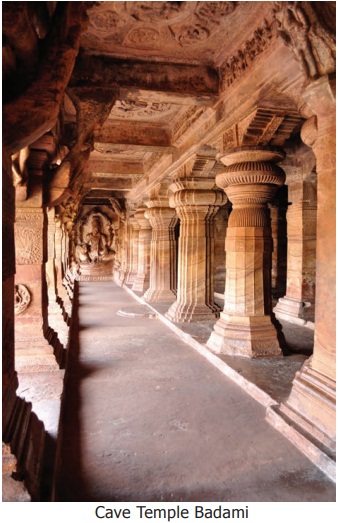
The cave temples at
Badami contain fine sculptures of Vishnu reclining on Sesha Nag; Varaha, the
Boar; Narasimha or the lion-faced man; and Vamana, the dwarf. The Kasi
Vishweshvara Temple at Lakkundi, the Mallikarjuna Temple at Kuruvatti, the
Kalleshwara Temple at Bagali and the Mahadeva Temple at Itagi represent
well-known examples of the architecture of Western Chalukyas of Kalyani.
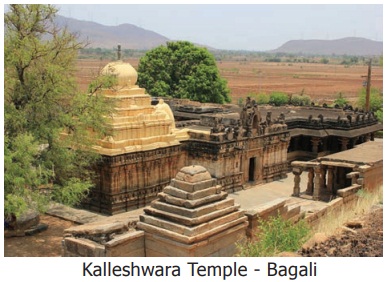
Chalukyas adopted
the Vakataka style in paintings. Some of the frescoes of the caves of Ajantha
were created during the reign of Chalukyas. The reception given to the Persian
embassy by Pulakesin II is depicted in a painting at Ajanta.
Pattadakal (UNESCO World Heritage Site)
is a small village in Bagalkot district of Karnataka. It has ten temples. Out
of them, four were built in northern style (Nagara) , while the rest six are in
the southern (Dravida) style. Virupaksha Temple and Sangameshwara Temple are in
Dravida Style and Papanatha temple is in Nagara style. The Virupaksha temple is
built on the model of Kanchi Kailasanatha temple. Sculptors brought from Kanchi
were employed in its construction.
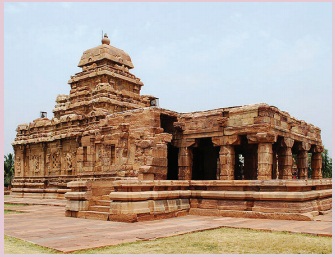
The
Rashtrakutas
The Rashtrakutas
ruled not only the Deccan but parts of the far south and the Ganges plain as
well from 8th to 10th century AD(CE). They were of Kannada origin and their
mother tongue was Kannada. Dantidurga was the founder of Rashtrakuta dynasty.
He was an official of high rank under the Chalukyas of Badami. Krishna I
succeeded Dantidurga. He consolidated and extended the Rashtrakuta power. He
was a great patron of art and architecture. The Kailasanatha temple at Ellora
was built by him.
Rashtrakuta
Kings
The greatest king
of the Rashtrakuta dynasty was Amogavarsha. He built a new capital at
Manyakheta (now Malkhed in Karnataka) and Broach became the port. Amogavarsha
(c. 814–878) was converted to Jainism by Jinasena, a Jain monk. Krishna II, who
succeeded his father Amogavarsha, suffered a defeat in the battle of Vallala
(modern Tiruvallam, Vellore district) at the hands of Cholas under Parantaka in
c. 916. Krishna III (c. 939–967) Was the last able ruler of Rashtrakuta
dynasty. He dfeated the Cholas in the battle of Takkolam (presently in
Vellore district) and captured Thanjavur. The Chalukyas under Krishna III
contested with other ruling dynasties of north India for the control of Kanauj.
He built Krishneshwara temple at Rameshwaram.Govinda III was the last ruler to
hold the empire intact. After his death, the Rashtrakuta power declined.
Contribution
of Rashtrakutas to literature, art and architecture
Literature
Kannada language
became more prominent. Kavirajamarga composed by Amogavarsha was the
first poetic work in Kannada language. Court poets produced eminent works in
Kannada. The three gems of Kannada literature during the period were Pampa, Sri
Ponna and Ranna. Adikavi Pampa was famous for his creative works Adipurana
and Vikramarjunavijaya. The life of Rishabadeva, the first Jain
Tirthankara is depicted in Adipurana. In Vikramarjunavijaya
Pampa’s patron, Chalukya Arikesari, is identified with Arjuna, epic hero of
Mahabharatha.
Art and architecture
The Rashtrakutas
made significant contribution to Indian Art. The art and architecture of the
Rashtrakutas can be found at Ellora and Elephanta.
Kailasanatha
Temple – Ellora (near Aurangabad, Maharashtra)
Kailasanatha Temple
was one of the 30 temples carved out of the hill at Ellora. It was built during
the reign of Krishna I. The temple is known for its architectural grandeur and sculptural
splendour. The temple covers an area of over 60,000 sq. feet and vimanam
(temple tower) rises to a height of 90 feet. This temple has resemblance to the
shore temple at Mamallapuram. The Kailasanatha temple portrays typical
Dravidian features.
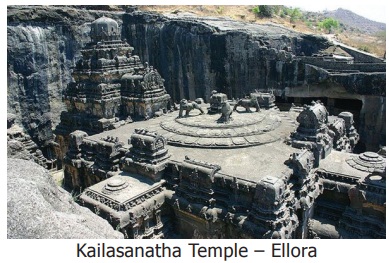
Elephanta
Island
Originally known as
Sripuri and called Gharapuri by the local people, Elephanta is an island near
Mumbai. The Portuguese named it as Elephanta, after seeing the huge image of an
elephant. The Trimurthi (three-faced) Siva icon is an illustrative of the
sculptural beauty portrayed in the Cave Temple of Elephanta. There are
impressive images of dwarapalakas (entrance guards) at the entrance of
the Temple.

Pattadakal
Rashtrakutas built
temples in the complex of Pattadakal. The Jain Narayana temple and the Kasi
Vishwesvara temple were built by Rashtrakutas.
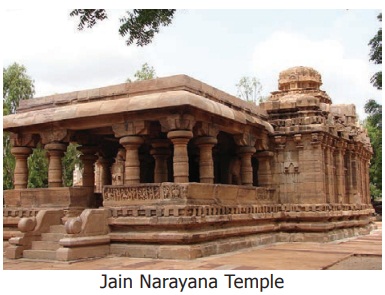

Summary
* By the early 7th century, South India had come
under the control of Pallavas of Kanchi and Chalukyas of Badami
* Pallava period is known for architectural
splendour. Pallava architecture can be classified as rock-cut temples,
structural temples. monolithic rathas and mandapams
* The Chalukyas contributed richly to art and
architecture. A new style of architecture known as Vesara style developed
during their period
* The Rashtrakutas also made significant
contribution to Indian art. Their art and architecture can be found at Ellora
cave and Elephanta island
GLOSSAY
1. feudatories
being subject to a sovereign சிற்றரசர்கள்
2. ambassador
envoy தூதுவர்
3. granite
a very hard rock கருங்கல்
4. ravaged
severely damaged சூறையாடிய
5. descendants
offspring வழித்தோன்றல்கள்
6. reclining
leaning back சாய்ந்திருக்கக்கூடிய
ICT CORNER
HISTORY -
South Indian Kingdoms
This activity for Interactivity M is a UNESCO
World Heritage Sites helps now learn about ancient Heritage Sites
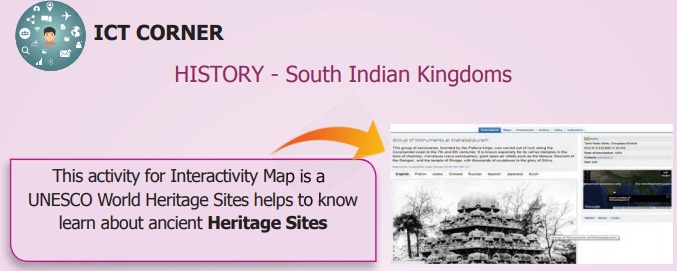
Steps:
Step 1: Open the Browser and type the URL given
below (or) Scan the QR Code.
Step 2: World Heritage Centre page will appear on
the screen.
Step 3: Double click or Zoom any tagged sites or
places. (ex. Mamallapuram)
Step 4: You can see collective pictures, videos
and more details.

Pictures are indicatives
only.
Browse in the link
Web:
http://www.elections.in/ (or) scan the QR Code
Related Topics